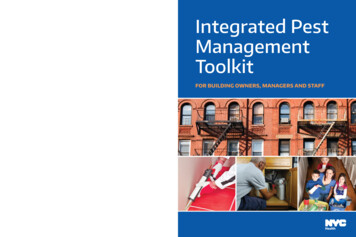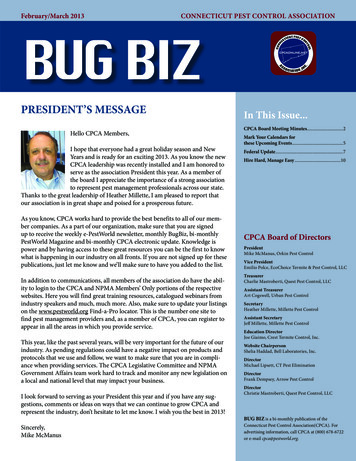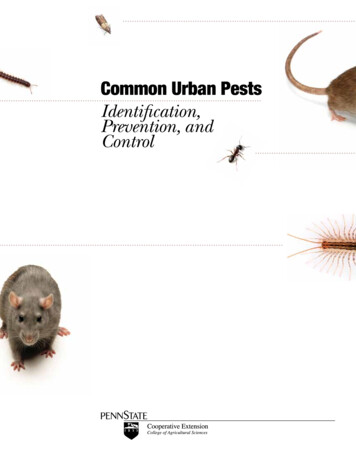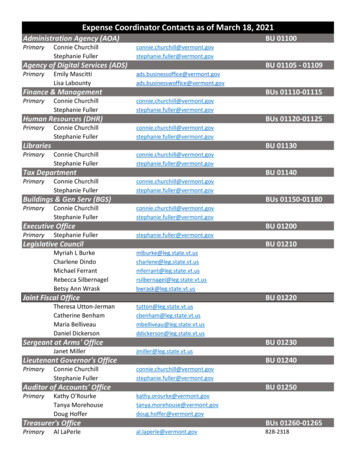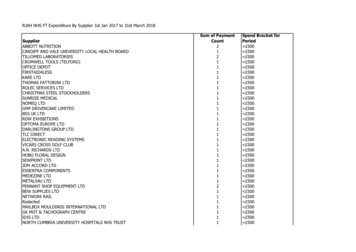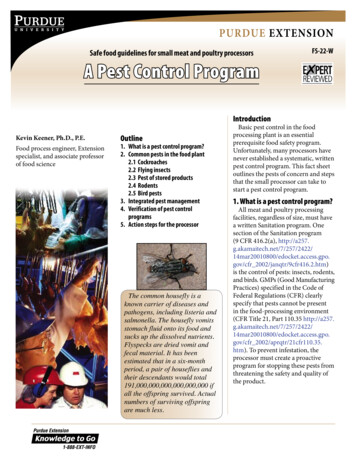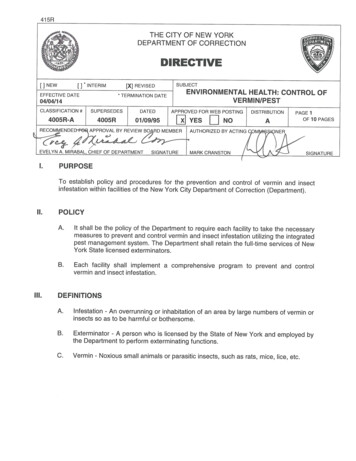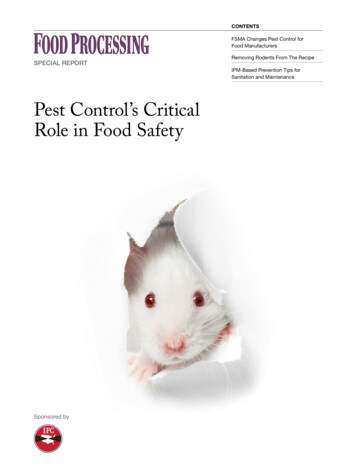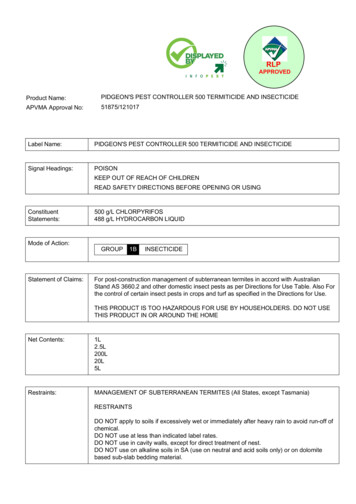
Transcription
RLPAPPROVEDProduct Name:PIDGEON'S PEST CONTROLLER 500 TERMITICIDE AND INSECTICIDEAPVMA Approval No:51875/121017Label Name:PIDGEON'S PEST CONTROLLER 500 TERMITICIDE AND INSECTICIDESignal Headings:POISONKEEP OUT OF REACH OF CHILDRENREAD SAFETY DIRECTIONS BEFORE OPENING OR USINGConstituentStatements:Mode of Action:Statement of Claims:500 g/L CHLORPYRIFOS488 g/L HYDROCARBON LIQUIDGROUP1BINSECTICIDEFor post-construction management of subterranean termites in accord with AustralianStand AS 3660.2 and other domestic insect pests as per Directions for Use Table. Also Forthe control of certain insect pests in crops and turf as specified in the Directions for Use.THIS PRODUCT IS TOO HAZARDOUS FOR USE BY HOUSEHOLDERS. DO NOT USETHIS PRODUCT IN OR AROUND THE HOMENet Contents:1L2.5L200L20L5LRestraints:MANAGEMENT OF SUBTERRANEAN TERMITES (All States, except Tasmania)RESTRAINTSDO NOT apply to soils if excessively wet or immediately after heavy rain to avoid run-off ofchemical.DO NOT use at less than indicated label rates.DO NOT use in cavity walls, except for direct treatment of nest.DO NOT use on alkaline soils in SA (use on neutral and acid soils only) or on dolomitebased sub-slab bedding material.
Directions for Use:This section contains file attachment.Other Limitations:Withholding Periods:HARVEST:ASPARAGUS, BANANAS, CELERY, CITRUS, GRAPEVINES, POME FRUIT, STONEFRUIT: DO NOT HARVEST FOR 14 DAYS AFTER APPLICATION.CEREAL GRAINS: DO NOT HARVEST FOR 10 DAYS AFTER APPLICATION.SUGAR CANE: DO NOT HARVEST FOR 7 DAYS AFTER APPLICATION.COLE CROPS, CUCURBITS: DO NOT HARVEST FOR 5 DAYS AFTER APPLICATION.TOMATOES: DO NOT HARVEST FOR 3 DAYS AFTER APPLICATION.GRAIN SORGHUM: DO NOT HARVEST FOR 2 DAYS AFTER APPLICATION.COTTON: DO NOT HARVEST FOR 4 WEEKS AFTER APPLICATION.GRAZING:CEREAL GRAINS, LEGUME, ANIMAL FEEDS, GRASSES, GRASS LIKE PLANTS,PASTURES AND OTHER FORAGES/FORAGE CROPS: DO NOT GRAZE OR CUT FORSTOCK FOOD FOR 2 DAYS AFTER APPLICATION.COTTON: DO NOT GRAZE OR CUT FOR STOCK FOOD FOR 4 WEEKS AFTERAPPLICATION.Trade Advice:General Instructions:This section contains file attachment.Resistance Warning:Insecticide Resistance WarningGROUP 1B INSECTICIDEFor insecticide resistance management, Pidgeon’s Pest Controller 500 Termiticide andInsecticide is a Group 1B insecticide.Some naturally-occurring insect biotypes resistant to Pidgeon’s Pest Controller 500Termiticide and Insecticide and other Group 1B insecticides may exist through normalgenetic variability in any insect population. The resistant individuals can eventuallydominate the insect population if Pidgeon’s Pest Controller 500 Termiticide and Insecticideor other Group 1B Insecticides are used repeatedly. The effectiveness of Pidgeon’s PestController 500 Termiticide and Insecticide on resistant individuals could be significantlyreduced. Since the occurrence of resistant individuals is difficult to detect prior to use,Superway Garden Products Pty Ltd accepts no liability for any losses that may result fromthe failure of Pidgeon’s Pest Controller 500 Termiticide and Insecticide to control resistantinsects.
Pidgeon’s Pest Controller 500 Insecticide may be subject to specific resistance strategies.For further information contact your local supplier or Superway representative.Precautions:Termite UsePRECAUTIONSDO NOT apply inside buildings except as a crack and crevice treatment. DO NOT apply tosurface areas such as interior floors or walls. Not for use in or around the home, garden,residential or publicly accessible spaces.RE-ENTRY TO TREATED AREASDO NOT permit re-occupation of any premises until treated areas are completely dry(normally 3-4 hours) and adequately ventilated.Agricultural and Horticultural UsePRECAUTIONSRe-entry to treated areas:Field Crops, tree crops and vines: Do not allow entry into treated crops until spray depositshave dried. If prior entry is required, limit duration of entry and wear cotton overallsbuttoned to the neck and wrist (or equivalent clothing) and chemical resistant gloves.Clothing must be laundered after each day’s use.Greenhouses: Do not allow entry into greenhouses until spray deposits have dried andtreated areas are adequately ventilated. If prior entry is required, limit duration of entry andwear cotton overalls buttoned to the neck and wrist (or equivalent clothing), chemicalresistant gloves and half-facepiece respirator. Clothing must be laundered after each day’suse.Cotton chippers: : Do not allow entry into treated crops until spray deposits have dried.After this time, wear shoes, or boots, socks, long trousers, long sleeved shirt, gloves andhat.Protections:Termite UsePROTECTION OF PETS AND LIVESTOCKBefore spraying remove animals and pets from buildings and other areas to be treated.Cover or remove any open food and water containers.Cover or remove fish tanks before spraying. DO NOT allow animals and pets to contacttreated areas for at least 24 hours.Dangerous to bees. DO NOT spray any plants in flower while bees are actively foraging.PROTECTION OF WILDLIFE, FISH, CRUSTACEANS AND ENVIRONMENTVERY HIGHLY TOXIC TO FISH AND AQUATIC INVERTEBRATES. Rinse waters and runoff from treated areas MUST NOT enter drains or waterways. For under-slab treatmentsthe moisture membrane MUST be installed immediately after treatment. DO NOT apply towaterlogged soils. DO NOT apply if heavy rains are expected to occur within 48 hours ofapplication.HIGHLY TOXIC TO BIRDS. Do NOT treat fill unless it has been placed back in the trenchto form the chemical soil barrier.DO NOT spray directly on to the foliage of plants as damage to some species is possible.Agricultural and Horticultural UsePROTECTION OF LIVESTOCKDangerous to bees. DO NOT spray any plant in flower while bees are actively foragingPROTECTION OF WILDLIFE, FISH, CRUSTACEANS AND ENVIRONMENTVERY HIGHLY TOXIC TO FISH AND AQUATIC INVERTEBRATES.HIGHLY TOXIC TO BIRDS AND REPTILES.DO NOT re-apply to the same crop within 7 days (unless specifically recommended in thedirections for use).Spray drift may occur under adverse meteorological conditions or from certain sprayequipment. DO NOT allow spray drift onto sensitive areas including, but not limited to,natural streams, rivers or waterways and human dwellings. A spray drift management
strategy such as those in the “Best management Practices Manual for Cotton Growers” orthe “Pilots and Operations Manual” should be applied.Options for minimising drift to sensitive areas include not spraying within a certain distanceof sensitive areas when the wind is blowing towards them (see table for guidance) orensuring that drifting spray will be intercepted by a catching surface such as a row ofshelter trees, an unsprayed row of orchard trees, or hail netting.Situation Recommended buffer distance (m)Orchard (dormant trees, citrus, large trees)* 30Cotton (aerial application) 300Other crops (aerial application) 100DO NOT apply if heavy rains or storms that are likely to cause surface run off are forecastin the immediate area within 2 days of application.DO NOT apply when irrigating to waterlogged soil, or while water remains on the surface orin furrows, unless tail water is captured on farm.DO NOT allow contaminated runoff from treated paddocks to enter adjacent areas or waterbodies. Runoff contaminated by irrigation events (tailwater) and a 25mm rain storm shouldbe captured on farm for two days after application.DO NOT spray directly on to the foliage of plants as damage to some species is possible.DO NOT contaminate streams, rivers or waterways with the chemical or used containers.Storage andDisposal:SMALL SPILL MANAGEMENTWear appropriate clothing and protective equipment whilst cleaning up small spills (seeSAFETY DIRECTIONS). Apply absorbent material such as earth, sand, cat litter or claygranules to the spill. Sweep up material and contain in a refuse vessel for disposal.If spilled inside a building, wash contaminated surfaces to deactivate the chlorpyrifos witha dilute solution of bleach (sodium hypochlorite), prepared according to the bleach labelinstructions.Dispose of the contaminated material in accordance with STORAGE AND DISPOSALinstructions below.STORAGE AND DISPOSALStore in closed, original container in a cool well-ventilated area. Do not store for longperiods in direct sunlight.Triple-rinse containers before disposal. Add rinsings to spray tank. Do not dispose ofundiluted chemicals on site.If recycling, replace cap and return clean containers to recycler or designated collectionpoint.If not recycling, break, crush, or puncture and deliver empty packaging to an approvedwaste management facility. If an approved waste management facility is not available,bury the empty packaging 500 mm below the surface in a disposal pit specifically markedand set up for this purpose, clear of waterways, desirable vegetation and tree roots, incompliance with relevant local, state or territory government regulations. Do not burn emptycontainers or product.Safety Directions:Product is poisonous if absorbed by skin contact, inhaled or swallowed. Repeated exposuremay cause allergic disorders. Repeated minor exposure may have a cumulative poisoningeffect. Will irritate the eyes and skin. Avoid contact with eyes and skin. Do not inhale vapouror spray mist. When opening the container, preparing the spray or using the preparedspray, wear chemical resistant clothing buttoned to the neck and wrist, a washable hat,elbow-length PVC gloves, goggles, chemical resistant footwear, and a half face-piecerespirator with combined dust and gas cartridge. If clothing becomes contaminated orwet with spray remove clothing immediately. If product is spilt on skin, immediately washarea with soap and water. If product in eyes, wash it out immediately with water. After useand before eating, drinking or smoking, wash hands, arms and face thoroughly with soapand water. After each day’s use wash gloves, goggles, respirator and if rubber wash withdetergent and warm water, and contaminated clothing.
First Aid Instructions:First Aid Warnings:If swallowed, splashed on skin or in eyes, or inhaled, contact a Poisons Information Centre(Phone Australia 131126) or a doctor at once. Remove any contaminated clothing andwash skin thoroughly. If swallowed, do NOT induce vomiting. If swallowed, activatedcharcoal may be advised. Give atropine if instructed. If in eyes, hold eyes open, flood withwater for at least 15 minutes and see a doctor.
APPLICATION INSTRUCTIONS – TERMITE MANAGEMENTAPPLICATION EQUIPMENTHand Spraying For hand spraying use a rose head shrouded nozzle operating at 170 kPa and with a flow meterand pressure regulator fitted to the hand-piece.Injection Through Concrete Slabs or Sealed Areas Use a sub-slab injector fitted with multi-directional tip (a B & G or similar system) with a 5 degreeupward angle (e.g. 3 way or 4 way) and operated at 170 kPa. Ensure a strong seal with the top ofthe drill hole to avoid leakage. For the best distribution, the injector needs to be held vertically atright angles to the slab and rotated during the application through 90 degrees if using a 4 waydispersion tip, or through 120 degrees for a 3 way dispersion tip.Injection into Soil Use a soil rod with a 3 or 4 way multi-directional tip (B&G, or similar) operated at 170 kPa. The 4way tip needs to be rotated during the application through 90 degrees and the 3 way tip through120 degrees.APPLICATION VOLUME To compensate for impervious soils such as clays where application of 5 L/m2 would cause run-off,it may be necessary to apply a volume of emulsion less than 5 L/m2. When reducing the volume ofemulsion used, increase the concentration accordingly to match the label rate by mixing therequired amount of Pidgeon’s Pest Controller 500 Termiticide and Insecticide per m 2 in a lesservolume of water. DO NOT use emulsion volumes less than 2 L for every square metre to betreated.Note: Use of emulsion volumes other than the recommended 5 L/m2 is only permitted when installingbarriers in exposed soil. It is not permitted when injecting through the slab or into sealed areas.Existing Structuresa) Strategic Drilling Through Slab, or Sealed AreasFor treatment of slabs when termites are entering the building through the slab and wherereticulation systems do not exist, slab drilling and injection will be required. In most cases, unlessthere is a known severe termite hazard, grid drilling of the slab is not required. Any such need is tobe determined by a licensed Pest Control Operator.Treatment needs to be made around the inside of all exterior walls to complete a termite barrier,along both sides of interior wall partitions, around plumbing / electrical or piping entry points andalong one side of major cracks or expansion joints.For a sand base or sandy soil, apply through a row of holes drilled 300 mm apart and 100-200 mmout from the wall, crack or pipe. For a clay base, apply through a row of holes drilled 150 mmapart and 100 mm from the wall, crack or pipe. Apply 10 L of emulsion per linear metre andensure the holes are securely plugged after treatment.b) External BarrierAn external barrier should be installed around the perimeter of the building and should circumferenceall pipes and service facilities. External barriers should be created by using either a vertical orhorizontal barrier, as determined by the building construction type and adjoining ground level. Anexternal barrier is an essential part of the treatment when relying on a chemical soil barrier toprovide the full termite management system as per AS 3660.An external horizontal barrier is only required when prevention of concealed vertical access by termitesis necessary at the perimeter (eg, when ground level is equal to the top of a slab, where the slab is alsoa barrier to concealed termite movement into the building). A vertical barrier is required whenprevention of concealed horizontal access is necessary (eg, where ground level is higher than buildingmaterial vulnerable to concealed horizontal entry by termites).i) Horizontal Barrier not for use in home,garden,residential or publicly accessible spaces: Usea rose head shower nozzle operated at 170 kPa to apply the required rateof 1.5L of the correctly diluted Pidgeon’s Pest Controller 500 Termiticide per lineal metre (150mmwide) to soil loosened to a depth of at least 80mm (see APPLICATION VOLUME Section).
ii) Vertical Barrier: The vertical barrier should be at least 150mm wide and should reach down to50mm below the top of the footings. To achieve this trench to the top of the footings, and where thisis not possible, a combination of trenching (preferably at least 300mm deep) and rodding into thebase of the trench may be necessary.Apply Pidgeon’s Pest Controller 500 Termiticide and Insecticide emulsion at 100L per cubic metreof backfill soil, this equates to 1.5L of emulsion/linear metre of a trench 150mm wide and 100mmdeep. Where the required vertical barrier is deeper than 100mm, ensure the same rate of applicationfor the extra volume of soil. Use a rose head shower nozzle operated at 170 kPa to flood the baseof the open trench and also to treat the backfill soil as it is replaced into the trench to ensure evendistribution. Where rodding is necessary, rod before the trench is treated using the spacings in thefollowing table.Rod Spacings:Heavy Clay150 mmClay Loams200 mmSands300 mmInsert the rod to the foundation foot as close as possible to the house wall ensuring thechemical is applied during insertion and withdrawal. (See APPLICATION EQUIPMENT Section,Injection into Soil).c) Suspended FloorsInstall horizontal and vertical barriers as specified in Australian Standard Series 3660 to abut allsubstructure walls, stumps, piers, pipes and wastes using the techniques described for externalbarriers around concrete slabs. (See Existing Structures Section.) Not for use in home, garden,residential or publicly accessible spaces.GENERAL INSTRUCTIONS – Termite ManagementTermite managementTo minimise the risk of termite infestation, the subfloor area of buildings should be kept free of storedor waste timber and all other building materials that attract termites. Appropriate action should also betaken to eliminate any undue dampness caused by leaking water or sewerage pipes, or inadequatedrainage. Subterranean termites need a constant source of moisture to survive. Provision of adequateventilation in the subfloor area also helps eliminate undue dampness. Pest managers using this productfor termite management should advise the home owner that disturbing the treated soil barrier withsubsequent construction of additions or alterations, paths, steps, landscaping, etc, may render thetermite management system in place ineffective unless further management options are considered.Colonies not in contact with the groundOccasionally subterranean termites establish a colony in a building without having contact with the soilbecause they have access to a continuous supply of moisture (eg. from a faulty plumbing fixture orleaking roof). Such colonies are not affected by chemical soil barriers and should be treated asrecommended for established colonies, as per Australian Standard Series AS 3660. Pidgeon’s pestController Termiticide and Insecticide may be applied directly to the termite colony in such situations.Service requirementRegular, competent inspections by a licensed Pest Manager are recommended as part of an overalltermite management program to determine the prevailing termite pressure and environmentalconditions and consequent requirement for further termite management options. Inspections should beperformed at least on an annual basis, but more frequent inspections are strongly recommended.At the 1% application rate, Pidgeon’s Pest Controller Termiticide and Insecticide can provide aneffective chemical soil barrier in subfloor regions for 4 years or more north of the Tropic of Capricorn,and 10 years or more south of the Tropic of Capricorn. At the 1% application rate, Pidgeon’s pestController Termiticide and Insecticide can provide an effective chemical soil barrier in exposedsituations for 2 years north of the Tropic of Capricorn, and up to 5 years or more south of the Tropic ofCapricorn.The actual period of efficacy will depend on many factors such as termite hazard, climatic conditions,soil types and soil disturbance and gardening/landscaping practices.
GENERAL INSTRUCTIONSTERMITE MANAGEMENT AND GENERAL PEST CONTROLMIXINGHalf fill the spray tank with water (or creosote where applicable) and add the required amount ofPidgeon’s Pest Controller Termiticide and Insecticide , then add the remaining water (or creosote) withan agitator running. If using a knapsack sprayer gently shake before using. Only mix sufficient chemicalfor each specific application.CLEANING SPRAY EQUIPMENTAfter using Pidgeon’s Pest Controller Termiticide and Insecticide, empty the spray equipmentcompletely and drain the whole system. Thoroughly wash inside the tank using a pressure hose, anddrain. To wash the system, quarter fill the tank with clean water and circulate through the pump, lines,hoses and nozzles (for knapsack sprayers spray to waste through the nozzle). Drain and repeat thewashing procedure twice.Disposal of rinsate/rinse water in accordance with Storage and Disposal instructions below.GENERAL INSTRUCTIONS – AGRICULTURAL AND HORTICULTURALMIXINGHalf fill the spray tank with water (or creosote where applicable) and add the required amount ofPidgeon’s Pest Controller 500, then add the remaining water (or creosote) with the agitator running. Ifusing a knapsack gently shake before using. Preferably only mix sufficient chemical for each specificapplication.APPLICATION (In Crop):Ground: Apply per hectare rates in sufficient water to give thorough coverage. See Directions for Usefor details.Aircraft: Apply in 10-50 litres of water per hectare.CLEANING SPRAY EQUIPMENTAfter using Pidgeon’s Pest Controller 500, empty the spray equipment completely and drain the wholesystem. Thoroughly wash inside the tank using a pressure hose, and drain. To wash the system,quarter fill the tank with clean water and circulate through the pump, lines, hoses and nozzles (forknapsacks spray to waste through the nozzle). Drain and repeat the washing procedure twice.Disposal of rinsate/rinse water in accordance with Storage and Disposal instructions below.
MANAGEMENT OF SUBTERRANEAN TERMITES (All States, except Tasmania)RATES OF APPLICATIONIMPORTANT: Pidgeon’s Pest Controller 500 Termiticide and Insecticide should be used as part of an overall termite management program as detailed in AustralianStandard Series AS 3660. A great deal of care is required to understand construction details of the building and to apply the product in a manner which ensures acomplete chemical soil barrier. Where necessary, the barrier may need to be re-applied under the building. Application equipment must be fitted with a flow meterand pressure regulator on the application device. The purpose of a chemical soil barrier is to impede and discourage concealed termite entry into a structure.Barriers may still be bridged by termites, but their entry can then be more easily detected during routine inspections. If a barrier is not complete or breached, thenconcealed termite entry may occur. It is often not possible to form a complete barrier around existing structures in which case other termite management optionsand/or more frequent inspections will also need to be considered.SITUATIONInstalling a chemical soilbarrier around and underbuildings.RATECRITICAL COMMENTSHorizontal Barriers:100mL/m2Vertical Barriers:2L/m3Horizontal Barriers: Use 100mL of Pidgeon’s Pest Controller 500 Termiticide and Insecticide per 5Lof water and apply the mixture (emulsion) at a rate of 5L/m2.Vertical Barriers: Use 2L of Pidgeon’s Pest Controller 500 Termiticide and Insecticide per 100L ofwater and apply the mixture at a rate of 100L/m3.See APPLICATION VOLUME section in GENERAL INSTRUCTIONS for further information.2L/100L is equivalent to a 1% active ingredient emulsion.See Service requirement in GENERAL INSTRUCTIONS for expected barrier life.200mL/10L of wateror creosoteTrench (preferred) or rod and puddle-treat backfill, ensuring a complete and continuous treated soilbarrier is provided around the pole or post, to a minimum depth of 300mm and minimum width of150mm. Use 100L of emulsion per m3 of soil. In addition, infested poles may be drilled near groundlevel and the cavity flooded with the emulsion. This allows seepage to form a treated soil barrier.Note: A 50mm gap between fence palings and soil will reduce termite attack and fungal decay. Onlysoil in contact with palings should be treated. Replenishment is recommended within 2 years north of the Tropic of Capricorn and 5 years inother areas. If the barrier is disturbed, or rain falls immediately after application, retreat to restore continuity andcompleteness of the barrier.Refer to Australian Standard Series AS 3660.Note: Not inresidential/home/publicspacesInstalling a chemical soilbarrier around new andexistingpoles,eg.transmission and buildingpoles, fence posts andpalings.Note: Not inresidential/home/publicspaces
Treatment of termite nest orcolony.100mL/10L of waterOnce the nest or colony has been located it should be broken open and flooded with emulsion. Thisincludes nests located in trees. When treating trees, the addition of a wetting agent is suggested.Refer to Australian Standard Series AS 3660.NOT TO BE USED FOR ANY PURPOSE, OR IN ANY MANNER, CONTRARY TO THIS LABEL UNLESS AUTHORISED UNDER APPROPRIATELEGISLATION.
DIRECTIONS FOR USE: GENERAL PEST CONTROLSITUATIONCommercial and industrialareasNote: Not idual controland/or heavyinfestations)SpidersSilverfishCockroaches (lightinfestations)Ants includingArgentine antsCommercial and industrialareasFleasHides/SkinsHide beetlesRATE95 mL/10 L of water50 mL/10 Lof water95 mL/10 L of water.Use at least1 L spray/10 m2infested area50 to 90 mL/10 Lof water200 mL/100 L of water.Use at least 30 ml ofspray / sheep skinCRITICAL COMMENTSApply as a coarse, low pressure spray to the point of run-off, tocracks, crevices, harbourages, eaves, downpipes and other placeswhere the pests may occurFor maximum spider control use a 2-part treatment1. Crack and Crevice2. Overall band spray of surfacesLocate ant nests and treat appropriately and spray ant tracks orwhere ant activity is noticed. Apply to paths in continuous 30 cmbands. Apply to base of buildings, walls, fences, rock-works, trunksof shrubs and trees, and other hard surfaces to a height of 30 cm.Apply as a fine droplet spray. Indoors. Use lower rate to treat infested rugs, carpets, animalbeds and resting places. Outdoors. Use higher rate to treat area where animals frequent. Remove animals during treatment and until spray deposit isdry. Do not treat pets with this product. Pets should be treatedwith a product registered for application to animals only.Apply spray to flesh side of skins or hides sufficient to moistenthem. Ensure coverage of ears and lugs. To minimise the chanceof later infestations, storage area should be sprayed regularly.Repeat application every 3 months. Access through bales shouldbe maintained for application of insecticide.
SITUATIONLight vegetationNote: Not inresidential/home/publicspacesMedium vegetationNote: Not inresidential/home/publicspacesHeavy vegetationNote: Not inresidential/home/publicspacesLight to medium vegetationNote: Not inresidential/home/publicspacesMedium to heavy vegetationNote: Not inresidential/home/publicspacesPolluted water impoundmentsNote: Not inresidential/home/publicspacesPESTMosquito larvaeRATE30 mL/haCRITICAL COMMENTSDilute with water and apply as a spray to areas infested withmosquitoes.60 mL/ha105 mL/haMosquito adults60 mL/ha105 mL/haMosquitoes (larvaeand adults)2 mL/10,000 L of water or 20mL/100 m3 of waterNOT TO BE USED FOR ANY PURPOSE, OR IN ANY MANNER, CONTRARY TO THIS LABEL UNLESS AUTHORISED UNDERTHE APPROPRIATE LEGISATION.
DIRECTIONS FOR USE – AGRICULTURAL AND HORTICULTURAL USE ONLYCROPPESTSTATERATEAPPLES,PEARSSan Jose ScaleQld, NSW, SA,WA100 mL/100 L waterWingless GrasshopperNSW onlyBanana Scab MothQld onlyBanana Weevil BorerQld, NSW only500 mL/ha in100-150 L waterAerial: 1 or 2.0 L/hause a minimum of 10L/ha of water,or200 mL/100 L wateruse a minimum of500 L/ha water1 or 1.8 L in 100 LwaterCaterpillarsNSW only200 mL/100 L waterLight brown apple mothNSW only500 or 700 mL/haWHPCRITICAL COMMENTS14 days(Harvest)Dormant Period: Add 2% Winter Oil. Apply as late aspossible ensuring thorough spray coverage.Growing Period: Apply to coincide with crawler activity(mid-November and later). Ensure thorough coverage.Apply as aphid build-up is first noticed ensuring spraycoverage is thorough.Spray ground areas infested with hoppers. Also apply as abarrier across the line of advance as crops are invaded.Apply as flowers first appear and repeat as required untilfingers are exposed. Use higher rate in wet weather orunder heavy insect pressure.Woolly aphidBANANASCARROTS14 days(Harvest)-Sub-Tropical Areas: Use high rate for annual control ofborers.Tropical Areas: Use high rate in Sept-Nov for initial sprayand follow with low rate in February-April should insectnumbers warrant a second application. After trash removal,apply 500-700 mL of spray mixture to lower 30 cm of thebutt and surrounding soil within a 30 cm radius. Ensurethorough coverage of butt and suckers.Apply from first appearance of flower bells and repeat asrequired until fingers are exposed. Ground application only.DO NOT apply by air.Apply when moths are first detected. Repeat at higher rateif re-infested.
CROPCITRUSPESTCalifornia Red ScaleWingless GrasshopperCOLE CROPS:Broccoli,Brussel sprouts,Cabbage,CauliflowerGRAPESCabbage moth,Cabbage white butterfly,Cabbage aphid,Cluster caterpillar,Cabbage cluster caterpillarCorn earworm,Native budwormSTATERATENSW, Vic, SA,WA, only100 mL alone or50 mL 1L misciblesummer spraying oilQld only100 mL 1L misciblesummer spraying oil500 mL/ha in 100-150L water1.5 or 2.0 L/haNSW, SA, Vic,Tas onlyNSW, SA, Vic,WA onlyQld onlyCorn earwormNSW, Vic, SA,WA onlyNative budwormNSW, VIC, SA,Tas, WA onlyWingless grasshopperNSW, Vic, Tas,SA only150 mL/100 L water,or1.5 L/ha1.5 or 2.0 L/haor 150 or 200 mL/100L water1.5 or 2.0 L/haor 150 or 200 mL/100L water500 mL/ha or 50mL/100 L waterRedlegged earth mite,Blue oat miteNSW only140 or 300 mL/haGrape Vine ScaleQld, NSW, WA,SA, Tas only100 mL/100 L water,or 50 mL/100 L water 1L Winter Oil50 mL/100 L water, or500 mL/haGrape Vine MothLight Brown Apple MothAll StatesWHPCRITICAL COMMENTS14 days(Harvest)Application period November-March. Two sprays may berequired for control under heavy infestations. Apply througha high volume sprayer to the point of run-off. DO NOT usein integrated pest control programs.5 days(Harvest)2 days(Grazing)Spray areas infested with hoppers. Also apply as a barrieracross the line of advance as crops are invaded.Spray at 10-14 day intervals using the higher rate underheavy pest pressure. Use 1000 L/ha of water on largerplants. For improved coverage, add a non-ionic wettingagent as recommended.Apply when pests first appear. Use 1000 L/ha of water onlarger plants.5 days(Harvest)Apply when pests first appear. Use 1000 L/ha of water onlarger plants.Apply at 10 day intervals. Use high rate under heavy pestpressure. Large plants: use 1000 L/ha.14 days(Harvest)Spray areas of crop infested with grasshoppers. Also applyas a barrier across line of advance, when grasshoppers areinvading the crop.Use higher rate for severe infestation. Headlands andvegetation surrounding the crop may also need to besprayed.Apply as a dormant spray following pruning (July).Apply initial spray just after berry set (early October).Repeat application as required.
WHPCRITICAL COMMENTSPINEAPPLESCROPPineapple mealy bug,AntsPESTQld onlySTATE
For insecticide resistance management, Pidgeon's Pest Controller 500 Termiticide and Insecticide is a Group 1B insecticide. Some naturally-occurring insect biotypes resistant to Pidgeon's Pest Controller 500 Termiticide and Insecticide and other Group 1B insecticides may exist through normal genetic variability in any insect population.

